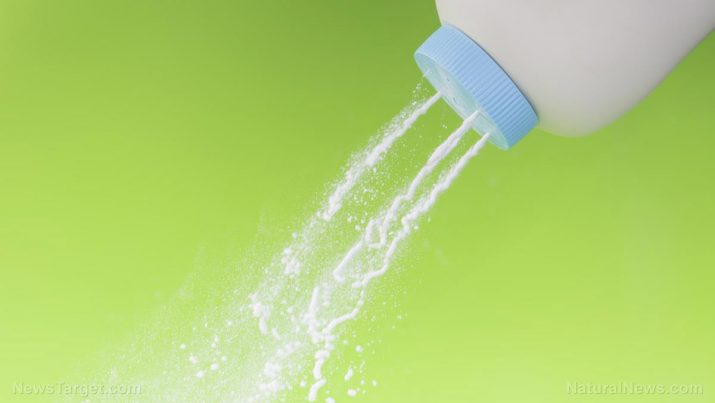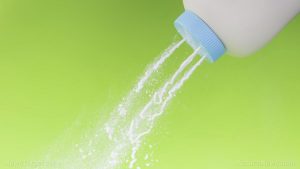
Talc – toxicity, side effects, diseases and environmental impacts
Thursday, November 23, 2017 by Janine Acero
http://www.naturalpedia.com/talc-toxicity-side-effects-diseases-and-environmental-impacts.html

Talc (also known as talcum or hydrous magnesium silicate) is known as the softest mineral on earth. It is an odorless white to grayish-white very fine crystalline powder, but its solid form can appear in beige, gray, yellow, brown, pink, purple, blue and green.
Talc has a greasy feel and can have a waxy or pearly surface. It is insoluble in water and may also be lightly fluorescent. Talc readily adheres to the skin and is nonflammable, noncombustible, and nontoxic.
Solid forms of talc are found in metamorphic rocks and are assumed to be safe. However, respiratory diseases are known to be associated with talc when inhaling its powder form.

List of known side effects
Inhalation of talcum powder is the most common exposure in humans. Talc is used as a dusting powder for babies to reduce diaper rashes. This raises the risk of inhaling the fine dust, which may inflame the lungs. Prolonged exposure may lead to progressive respiratory failure, while asphyxia and cardiorespiratory arrest may occur following severe aspiration.
Other symptoms of inhalation of talcum powder include fast and shallow breathing, coughing, dyspnea, tachycardia, tachypnea, sneezing, a blue tint to the skin (cyanosis), diarrhea or vomiting, convulsions, pulmonary edema, and involuntary movement in the arms and legs.
Talc is also a severe eye irritant and has been known to cause symblepharon, a serious eye condition that requires surgical correction.
Additionally, talc should not be applied to broken skin. When talc contaminates open wounds, it can cause a severe granulomatous reaction.
The International Agency for Research on Cancer (IARC) classifies talc as carcinogenic to humans with the presence of asbestos in talc’s natural form. TV adverts have long persuaded women to dust their private parts with talcum powder to mask alleged genital odors, which may lead to an increased risk of ovarian cancer in women who were exposed to talc powder repeatedly.
Occupational exposure to talc powder may cause other diseases, including:
- Lung cancer
- Fibrotic pneumoconiosis
- Endometrial cancer
Body systems affected by talc
Aspiration of fine talc powder may irritate and cause serious damage to the eyes, respiratory, cardiovascular and reproductive systems.
Items that contain talc
Talc can be found in personal care products such as baby powder, shower products, lotions, feminine hygiene products, eyeshadow, foundation, lipstick, deodorants and face masks.
Aside from reducing skin rashes, talc has been used as filler for paper, rubber, soap, and roofing asphalt. It is also widely used as a pigment in paints, ceramics, putty, plaster, rubber, varnishes and in cosmetics.
Talc can also be found in chewing gum, electrical insulation, insecticides, lubricants, medicinal and toilet preparations, polishing compounds, slate pencils and crayons, and vitamin supplements.
When talc is isolated as a pure mineral, it is composed of 63.6 percent silicon dioxide, 21.89 percent magnesium oxide and 4.75 percent water, but pure talc has never been used as an industrial commodity.
Talc is available in the following grades: crude, washed, air-floated, USP, fibrous.
How to avoid talc
Most health concerns are only after prolonged exposure, but it is still advisable to wash hands after handling talc.
Avoid personal care and cosmetic products that contain talc if used in the pelvic area. Choose companies that certify their products containing talc is free of asbestos.
Consider safer alternatives to talc, such as:
- Cornstarch
- Arrowroot starch or tapioca starch
- Baking soda
- Oat flour
Where to learn more
- Talcum powder as dangerous as asbestos
- Your Daily Additives – Anticaking Agents – Magnesium Silicate
- Johnson & Johnson ordered to pay $110 million to woman who developed cancer from using their talc baby powder
- Antiperspirants and Deodorants: Do You Know What You Are Spraying Under Your Arms?
- Talc and Ovarian Cancer Case: Pharmaceutical Company Found Guilty
Summary
Talc is an odorless white to grayish-white very fine crystalline powder.
Talc is used as a dusting powder for babies to reduce diaper rashes.
Talc can cause severe respiratory problems when inhaled in large quantities or repeated aspiration. It is also carcinogenic to humans.
Sources include:
Tagged Under: Tags: talc





